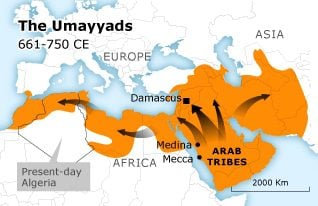
Introduction
Modern humans have inhabited Algeria for at least 40,000 years (and probably for 2 million years by earlier humans). Stone carvings and rock paintings in the Saharan area of Tassili n’Ajjer, near Djanet, date back at least six thousand years. Profound changes in the climate, which became drier and hotter, led to a shrinking of the Sahara population. About 300 BCE, the northern Mediterranean plains were part of the Berber empire of Numidia, which included much of North Africa. Its rulers became involved in a complicated game of alliances with the Mediterranean superpowers of Carthage and Rome. Part of what is now Algerian territory was incorporated into the Phoenician and Carthaginian empires based in present-day Tunisia before being conquered by the Romans. Although many Numidians had served in the Carthaginian army, the Numidian king Masinissa (ca. 240-148 BCE) struck an alliance with the Roman Empire.
This led to the establishment of a large Berber state, essentially a federation of sedentary communities. Masinissa’s grandson Jughurtha (ca. 160-104 BCE) wanted more independence from Rome, which sparked a conflict that led to the Berber king’s death. Even today, Berber cultural activists refer to this era as a historical example of its former power.
For the Romans, present-day northern Algeria’s lands were an important part of the empire because of their strategic location and their role as a supplier of foodstuffs for the empire. Ruins such as those at Timgad, Djémila, and Tipaza still testify to the Roman era. However, many communities further south and in mountainous regions remained largely outside the empire’s control, a situation that continued through the Arab and Ottoman periods and some decades into the French colonial era. The town of Constantine, which has existed for at least 2,500 years, was the Christian theologian Augustine’s birthplace (354-430).
The Coming of Islam

 At the turn of the 8th century, Arab forces under the new religion of Islam conquered large parts of present-day Algeria. It was only in the 10th century, after a second wave of migrants from the east, that the Arab culture became dominant, and their language and culture made a lasting imprint on the country. The Arab conquests led to conflicts with the Berbers. Later, the Arabs, who had always been few, mixed with the Berber population, which had probably arrived in an earlier migration from the Middle East.
At the turn of the 8th century, Arab forces under the new religion of Islam conquered large parts of present-day Algeria. It was only in the 10th century, after a second wave of migrants from the east, that the Arab culture became dominant, and their language and culture made a lasting imprint on the country. The Arab conquests led to conflicts with the Berbers. Later, the Arabs, who had always been few, mixed with the Berber population, which had probably arrived in an earlier migration from the Middle East.
 In the following centuries, the country was part of various Arab and Berber Muslim empires. In the 10th century, the Zirid dynasty founded the city of Algiers. Originally allied to the Shiite Fatimid rulers who were based in Egypt, the Zirids returned to Sunni Islam and sought to rule large parts of North Africa.
In the following centuries, the country was part of various Arab and Berber Muslim empires. In the 10th century, the Zirid dynasty founded the city of Algiers. Originally allied to the Shiite Fatimid rulers who were based in Egypt, the Zirids returned to Sunni Islam and sought to rule large parts of North Africa.
A period of confrontations ensued, with rival Arab armies coming from the east and the Almoravid Empire’s rise that took control of Algiers in the 11th century. In turn, this Berber dynasty, based in Marrakech, lost control of their territories to the Almohads, whose leader, Abd al-Mumin, was a native of western Algeria and founder of Nedroma. As a result of these conquests, Algeria has been closely connected to the neighboring territories of the Maghreb, including al-Andalus, in present-day Iberia.

